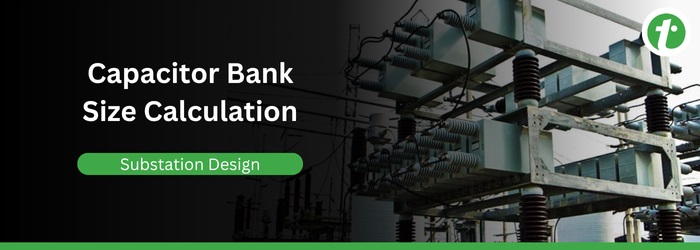
- Transformers
- Transformer Selection and Sizing
- Ratings of Circuit Breakers
- Ratings of Isolators
- Voltage Transformer
- Current Transformer
- Low Power Current Transformers
- Standard Ratings
- Design & Calculations
- Busbar Size Calculation
- Short Circuit Current Calculation
- Capacitor Bank Size Calculation
- Cable Size Calculation
- Voltage Drop Calculation
- Useful Resources
- Substation Design - Useful Resources
- Substation Design - Discussion
Capacitor Bank Size Calculation in Substation Design
In electrical substations, reactive power plays an important role in keeping the system voltage levels withing the permissible limits and improving the operational efficiency of the system. However, various electrical loads like electric motors, fluorescent lights, etc. consume reactive power and results in low power factor and increased losses in the system. Therefore, reactive power consumed by these load devices is supplied from an alternative source which is called capacitor bank.

The primary purpose of a capacitor bank in substations is to provide reactive power and improve the power factor. It also helps in maintaining the system voltage within the permissible limits. Read this chapter to learn the basics of capacitor bank size calculation in substation design.
What is a Capacitor Bank?
A collection of interconnected capacitors used in electrical power system to provide reactive power for power factor improvement is called a capacitor bank. Hence, a capacitor bank is nothing but a source of reactive power usually installed in substations for following key purposes −
- Power factor improvement
- Stabilize voltage levels
- Increase system efficiency
- Reduce reactive power demand from main power source
- Avoid penalty changers due to low power factor, etc.
Theory of Capacitor Bank
As capacitor bank provides reactive power (Q) which is measured in kVAR and is related to active power (P) and apparent power (S) as follows −
$$\mathrm{S \:=\: \sqrt{P^{2} \:+\: Q^{2}}}$$
The power factor is defined as the ratio of active power to the apparent power i.e.,
$$\mathrm{\cos\phi \:=\: \frac{P}{S}}$$
Where, $\mathrm{\:\phi\:}$ is the phase angle between system voltage and line current.
We can also calculate the reactive power produced by the capacitor bank to improve the power factor from initial value $\mathrm{\:\cos\phi_{1}\:}$ to new desired value $\mathrm{\:\cos\phi_{2}\:}$ by using the following relation,
$$\mathrm{Q_{c} \:=\: P \:\times\: (\tan\phi_{1} \:-\: \tan\phi_{2})}$$
After getting a basic understanding of capacitor bank and its theory, let us now discuss the step-by-step procedure to calculate the size of capacitor bank.
Calculation of Capacitor Bank Size
The step-by-step procedure for calculating the size of capacitor bank is explained here -
Step 1 - Let us consider a substation of 11 kV voltage class with the following parameters
Active power or connected load = 5 MW = 5000 kW
Current power factor = 0.80 lagging
Desired power factor = 0.97 lagging
Step 2 - Find the phase angles corresponding to current and desired power factor
$$\mathrm{\phi_{1} \:=\: \cos^{-1}(0.80) \:=\: 36.87^{\circ}}$$
$$\mathrm{\phi_{2} \:=\: \cos^{-1}(0.97) \:=\: 14.07^{\circ}}$$
Step 3 - Calculate the required capacitive reactive power for compensation and power factor improvement
$$\mathrm{Q_{c} \:=\: P \:\times\: (\tan\phi_{1} \:-\: \tan\phi_{2})}$$
$$\mathrm{\Rightarrow\: Q_{c} \:=\: 5000 \:\times\: (\tan 36.87 \:-\: \tan 14.07)}$$
$$\mathrm{\Rightarrow\: Q_{c} \:=\: 5000 \:\times\: 0.5 \:=\: 2500\: kVAR}$$
Hence, we need 2.5 MVAR capacitor bank for the given substation and power factor improvement condition.
Step 4 - Choose appropriate voltage class and connection
Capacitor banks can be either star connected or delta connected and the connection type depends on the voltage level of substation. The following table provides typical capacitor bank voltage and connection type depending on the system voltage of substation.
| Substation Voltage Level | Capacitor Bank Voltage | Configuration |
|---|---|---|
| 11 kV | 11 kV | Can be used any star or delta. |
| 33 kV | 33 kV | Star connected with neutral grounded. |
| 66 kV and above | 11 kV | Star connected. |
Step 5 - Determine number of capacitor units
A capacitor unit has a standard rating like 200 kVAR, 11 kV or 300 kVAR, 11 kV, and so on. For example, if we are using 200 kVAR unit, then the number of capacitor units can be determined as follows −
$$\mathrm{No\: of\: capacitor\: units \:=\: \frac{2500}{200} \:=\: 12.50 \:=\: 13\:Units}$$
Hence, we need 13 capacitor units of 200 kVAR each for our given substation.
Step 6 - Select reactive power control and switching
Capacitor banks come in two configurations namely, fixed type and automatic switched type. Fixed type capacitor banks remain always connected to the system and they are used in small substations. While, the automatic switched type capacitor banks use APFC relay for switching based on load variations.
Standards Related to Capacitor Banks
The following table provides some national and international standards/references related to capacitor banks −
| Standard | Description |
|---|---|
| IS 2834 | Shunt Capacitors for Power Systems |
| IS 13925 | Shunt Capacitor Banks for AC Power Systems (Safety & Performance) |
| IEC 60871 | International Standard for Shunt Capacitors |
| CEA Regulations | Grid Standards for Reactive Power Compensation |
| CBIP Manual | Design Guide for Substations |
Important Practical Guidelines Related to Capacitor Bank Design
Some of the practical guidelines that design engineers supposed to follow for designing efficient and reliable capacitor banks in substations are given below −
- We should design 5% to 10% higher kVAR to account for losses within the system.
- The rated voltage of capacitor bank should be 10 to 15% higher than the nominal system voltage.
- Proper ventilation and isolation must be provided in the capacitor bank room.
- For large scale installations, SCADA based remote monitoring should be implemented.
Conclusion
In this chapter, we covered in detail the role of capacitor banks in substations and their sizing. In conclusion, a capacitor bank is one of the important components of a substation as it is used for improving operational efficiency, reduce system losses, stabilize voltage, and comply with regulatory standards.